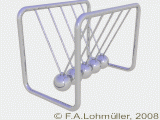Sorry....Kirk: What do you think our chances are of getting out of this alive?
Spock: Approximately 1 in 898.9853.
Kirk: Approximately.
Spock: (Lifting one eyebrow) Yes, captain.
Not a Trekkie fan....
Sorry....Kirk: What do you think our chances are of getting out of this alive?
Spock: Approximately 1 in 898.9853.
Kirk: Approximately.
Spock: (Lifting one eyebrow) Yes, captain.
It has been a few years, well decade or two since I was actively seeking this kind of knowledge, but please enlighten me. When I was young electrons flowed. As I got older, electrons were no longer necessarily a particle, possibly a wave, holes flowed instead of electrons, etc. Are we back to electrons as a particle that actually move, from one end of a wire to the other?
My favorite more easily demonstrable analogy is to line up to coins in a straight line on the table, all touching each other. Then take an 11th coin and flick it into the coin one the end of the line. The coin on the other end moves instantly, the energy transferred through the line of coins at the speed of light. But how FAR it moves has everything to do with the force at which the 11th coin was flicked into the lineup, the equivalence of voltage in the electron movement, mitigated by any friction of all of the coins against the table top, the equivalent of resistance.
I think the single rail car pushed into the tunnel full of them analogy works better.My favorite more easily demonstrable analogy is to line up to coins in a straight line on the table, all touching each other. Then take an 11th coin and flick it into the coin one the end of the line. The coin on the other end moves instantly, the energy transferred through the line of coins at the speed of light. But how FAR it moves has everything to do with the force at which the 11th coin was flicked into the lineup, the equivalence of voltage in the electron movement, mitigated by any friction of all of the coins against the table top, the equivalent of resistance.
Harder to demonstrate in front of someone though...I think the single rail car pushed into the tunnel full of them analogy works better.

Picard:What do you think our chances are of getting out of this alive?
Data: Approximately 1 in 898.985337438205.
Picard: Approximately.
Data: (Mildly surprised look) Yes, captain.
Harder to demonstrate in front of someone though...
I've also used a Newton's Cradle...

The number of free (able to move to conduct current) electrons in the wire is proportional to the mass of the wire. The number of electrons passing through a given cross section per unit time will be proportional to the current.If i have a #12 copper wire pulling 10 amps and a # 12 wire pulling 4 amps both 120 volt . are the electrons moving faster in the wire with 10 amps ? does the 10 amp wire have more electrons flowing ?
It's also important for stock trading. Trading computers have a minimum length of CATx cable they must use to make things "fair". "Fair" in that context is a laughable concept to the rest of us. end rant
No they don't. The actual crazy now is the miles of coiled fiber to simulate distance so your trade gets to Chicago, NY and Philly at exactly the same time even though you are in say Boston.
Sent from my LT26i using Tapatalk
From my calcs about:If i have a #12 copper wire pulling 10 amps and a # 12 wire pulling 4 amps both 120 volt . are the electrons moving faster in the wire with 10 amps ? does the 10 amp wire have more electrons flowing ?
It has been my observation that truly great humour is unrecognized by the vast majority of the population.Thanks.......
Sometimes my humour isn't appreciated.
Funny you should say that............It has been my observation that truly great humour is unrecognized by the vast majority of the population.
Is that for real? It was for sure in the first Star Trek. I made up the number, of course.

